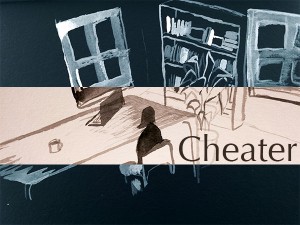 What I appreciate most about Theresa Duncan is that the intent behind her work was very straightforward. She was a feminist and she created alternative video games for girls in a male dominated field. She furthered her aim in a genteel and welcoming way for young girls. Aside from being a feminist visionary, Duncan was also multi faceted. She did not just work on video game creation, she was also a writer, blogger, artist, and filmmaker.
What I appreciate most about Theresa Duncan is that the intent behind her work was very straightforward. She was a feminist and she created alternative video games for girls in a male dominated field. She furthered her aim in a genteel and welcoming way for young girls. Aside from being a feminist visionary, Duncan was also multi faceted. She did not just work on video game creation, she was also a writer, blogger, artist, and filmmaker.
Duncan is probably most known for her early CD-ROM point and click adventures like Chop Suey. She created this game so that girls could experience something as intricate and interesting as mainstream audiences (male) do. My fascination with her stems from the accessibility and realness of her work (which animated and childish, it has a very grounded feel to it), the nostalgia I get from the old CD-ROM game feel, and the materials she used. I could make a game like that, but hers are imbued with expressiveness and interesting facets and meaning.
Her CD-ROM video games were recently given new life by Rhizome and are playable online.




 A while ago I played Limbo on my iPhone. I played it with a friend over the course of several weeks. The most thought provoking part for me was the elongated death scenes. I was often so eager to move on after a failure (and there were many failures) that I got impatient with the animation. Every time I died, I had to watch my character be impaled, or sink, or drown… The animations were intricate and individualized and beautiful. Clearly a lot of attention was paid to the death scenes and they were important (in a morbid way). After a few occurrences my own irritation became obvious to me and the lightness with which we take death and failure in video games. With a single minded commitment to completing the puzzle, and given the opportunity to immediately restart and often not deal with the consequences of failure… games that force the viewer to experience death in a slow and (slightly inconvenient way) really interrupt the gameplay and for me make me think of the incongruousness in experiencing failure in games.
A while ago I played Limbo on my iPhone. I played it with a friend over the course of several weeks. The most thought provoking part for me was the elongated death scenes. I was often so eager to move on after a failure (and there were many failures) that I got impatient with the animation. Every time I died, I had to watch my character be impaled, or sink, or drown… The animations were intricate and individualized and beautiful. Clearly a lot of attention was paid to the death scenes and they were important (in a morbid way). After a few occurrences my own irritation became obvious to me and the lightness with which we take death and failure in video games. With a single minded commitment to completing the puzzle, and given the opportunity to immediately restart and often not deal with the consequences of failure… games that force the viewer to experience death in a slow and (slightly inconvenient way) really interrupt the gameplay and for me make me think of the incongruousness in experiencing failure in games.